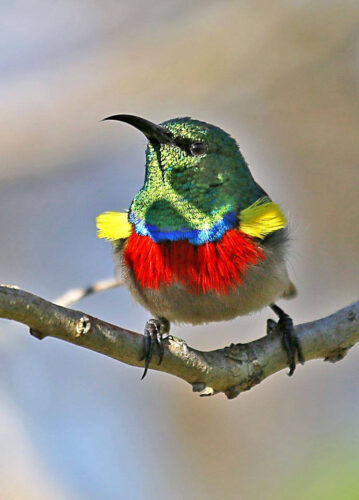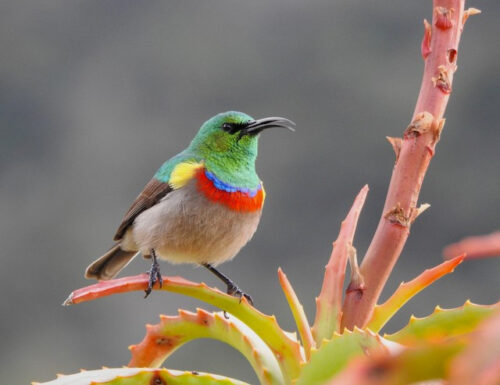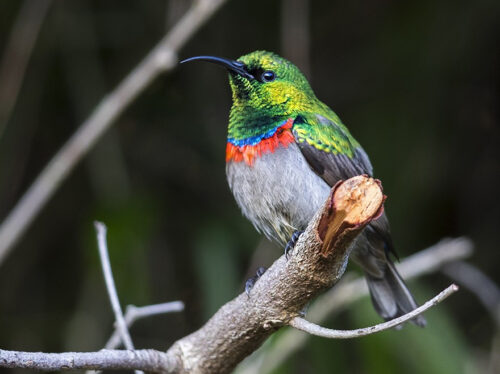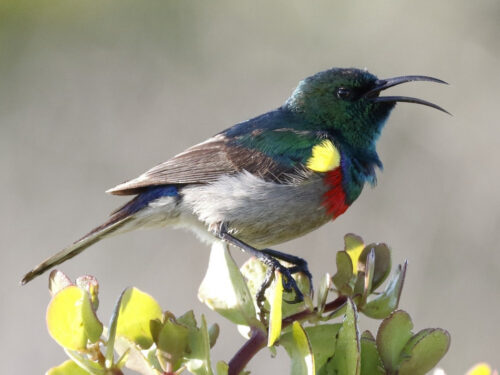
Immerse yourself in the captivating world of the Southern Double-collared Sunbird, a resplendent jewel found in the woods of South Africa.
This dazzling bird, reminiscent of hummingbirds in the Americas, boasts striking colors that shimmer in the sunlight.
With its flamboyant male and subtly hued female, this species presents a delightful challenge for birdwatchers.
Join us as we unveil the mesmerizing features, distinctive behaviors, and unique habitats of the Southern Double-collared Sunbird.
The Southern Double-collared Sunbird, measuring 12 cm in length, captivates with its glossy, metallic green head, throat, upper breast, and back.

A striking red band stretches across its chest, separated by a thin metallic blue band from the green breast, while the remaining underparts showcase a whitish hue.
During displays, yellow feather tufts on the shoulders become visible, adding to the bird’s allure.
With its long, downward-curving bill, black legs, and feet, and a captivating dark brown eye, this sunbird exudes charm from every angle.
Distinguishing the Southern Double-collared Sunbird from its close relative, the Greater Double-collared Sunbird, can be achieved through its smaller size, shorter bill, and narrower red chest band.
The female of this species displays brown upperparts and yellowish-grey underparts, while the juvenile closely resembles the female.
Contrasting with the female Orange-breasted Sunbird, the female Southern Double-collared Sunbird exhibits a greyer underpart and darker plumage below.

The Southern Double-collared Sunbird is often seen alone or in small clusters, showcasing its swift and straight flight supported by short wingspans.
While its primary diet consists of nectar from flowers, it also consumes fruit and occasionally insects and spiders, especially while raising its young.
While it can gather nectar while hovering like a hummingbird, it often perches to feed.
Its distinct call, a sharp “chee-chee,” and its melodious song, a mixture of high-pitched tinkling notes that rise and fall in pitch and tempo for up to five seconds or longer, add to its enchanting presence.
This captivating species finds its habitat in various locations, including gardens, fynbos, forests, and coastal scrub.
Breeding seasons vary depending on the region, typically occurring from April to December.
The sunbird constructs its nest from plant materials, such as grass and lichen, held together with spider webs.
Oval-shaped with a side entrance, the nest is lined with feathers, wool, and plant down, occasionally featuring a porch.

Despite not being considered endangered, the Southern Double-collared Sunbird remains a frequent resident in the Upper Highway area of South Africa and parts of Swaziland.
The Southern Double-collared Sunbird embodies the extraordinary beauty of the avian world, captivating observers with its vibrant colors, agile flight, and melodious songs.
Its co-evolution with flowers has resulted in fascinating adaptations, including bill variations to suit different nectar sources.
As we delve into the rich tapestry of this remarkable species, we gain a deeper appreciation for the interconnectedness of nature and the intricate wonders it holds.
Whether in forests, gardens, or coastal landscapes, the Southern Double-collared Sunbird continues to enchant bird enthusiasts with its resplendent presence and serves as a reminder of the remarkable biodiversity that graces our planet.
Video:






